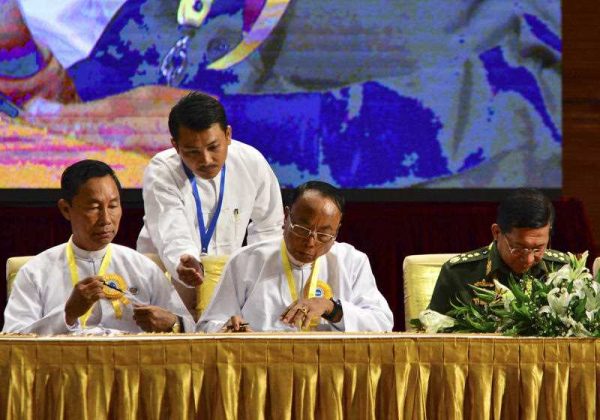But never before has Myanmar had a single, nationwide peace agreement of any kind. So will it be enough to secure peace?
Throughout the recent negotiations, conflict continued with the Kachin Independence Army (KIA). Yet an unprecedented ceasefire was reached with the Karen National Union, marking the first time any Karen group had signed onto any agreement with the central government since Burma’s independence in 1947.
The fact that the signature of the NCA was celebrated as a major event attended by leading national and international organisations speaks for itself. Even the National League for Democracy (NLD) was represented at a senior level, although Aung San Suu Kyi decided not to attend. The only organisations that boycotted the event seem to have been the armed ethnic groups excluded by the Myanmar government as ‘not ready’ for a ceasefire agreement. Several leading Myanmar organisations, including the NLD, attended the event as official ‘witnesses’. The Australian government also welcomed the agreement, claiming it had contributed AU$14 million (approximately US$10.1 million) to the peace process since 2012.
All parties concerned had invested a great deal of political capital, physical and intellectual resources, and effort into this process. Never before in the country’s history had so much time and preparation been directed at a single, structured negotiating process, where the details and practical consequences were spelled out at every step. It all took place with the benefit of lessons learned from Norway’s successful participation in the Sri Lanka ceasefire initiative in 2002.
Inside Myanmar, the public increasingly saw the post-2011 political transition as without value if insurgencies still continued and the government did not prioritise peace negotiations as part of the continuing reconciliation process. So signing the NCA was rightly seen as essential. But was the quality of the agreement sacrificed for political expediency?
Despite its limitations, observers should not be too hasty in dismissing the importance of what has been achieved in the NCA. It has been no easy task to reach this point of agreement. Until now, no central government in Myanmar has ever negotiated with such determination and in the public gaze. And this was achieved, even though each individual ethnic group is still inclined to think mainly of their own advantage.
The NCA is certainly not as inclusive as it needs to be. Only half of the recognised ethnic groups signing on. The KIA, the Shan State Army and the United Wa State Army (UWSA) are notable absences. But this might still be rectified as negotiations continue. Several other key ethnic parties could yet be retrospectively included.
Some form of high-level political dialogue should be initiated as soon as possible with the minimum goal of laying out an agenda for further consideration by political leaders. Specific agreements may not be necessary immediately, but the overall political character of the deal needs to be communicated loudly and clearly. It might be better if this could be done with less bureaucracy and less formality. But the devil will be in the detail for every signatory. Due care and precision is essential.
The substance of what has been accomplished may be very general, but it is not trivial. To have the various Karen groups sign on is a significant landmark, as the Karen National Union leadership has itself publicly acknowledged. Karen groups have been fighting with the central government and with each other for more than 60 years.
To have so many key Myanmar parties in a single agreement and, hopefully, ongoing international support arrangements ready as well is worth celebrating — and replicating. Because the process is incomplete, the NCA will unfortunately not bring fighting to an end. But for many ethnic groups it will finally provide a basis for moving forward.
The next challenge is to deal urgently with the major outstanding ethnic issues. Myanmar must find a solution to the socially and economically devastating Kachin insurgency. And it needs to bring other smaller armed ethnic groups — which have already participated in some of the discussions — formally into the present arrangement. This will increase the credibility of the NCA and ensure its durability. For the moment, armed ethnic groups, such as the KIA and the UWSA, effectively miss out. They must be brought into the main peace-making process as soon as practicable.
Trevor Wilson is a visiting fellow at the Coral Bell School of Asia Pacific Affairs, The Australian National University.


Clarification: The Lady and the NLD declined to attend the signing ceremony as an official witness, though the NLD did send a representative to be present. Others who declined invitations to attend as witnesses include Hkun Htun Oo and his SNLD (2nd largest winner in the 1990 election), the UNA, and Min Ko Naing of 88GPOS, each of whom explained their absence as being due to the fact that the government had excluded some ethnic armed organizations from signing the agreement.
Two issues hopefully Mr. Wilson can clarify:
1) How is Norway’s participation in the 2002 Sri Lanka ceasefire initiative considered a success given the ultimate collapse of the ceasefire agreement, and later the destruction of the Tamil Tigers?
2)After the DKBA’s split from the KNU in the early 1990s, didn’t the DKBA (a Karen group)agree to a ceasefire agreement with the government?
Well the Sri Lankan ceasefire ended the civil war. I agree the results of that war, political and human were ghastly. Sri Lankans taking it out on each other.
Yes, the DKBA split off from the main Karen army and was coopted by the government and the army, and often fought alongside them. That just meant that for the ensuing few years the two Karen groups (one Christian, one Buddhist) fought each other. That was, in the end, seen by all as fairly futile, but some internal disputes are hard to wind up.